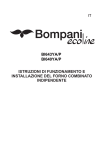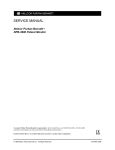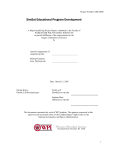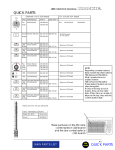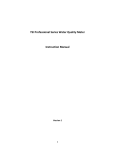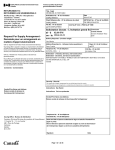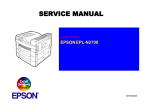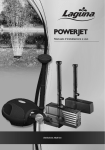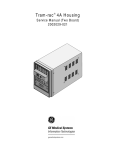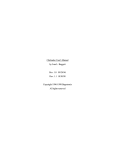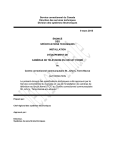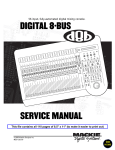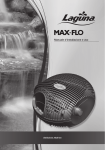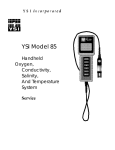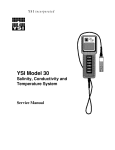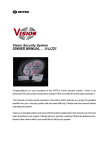Download YSI Model 5000/5100 Dissolved Oxygen Temperature Service Manual
Transcript
YSI MODEL 5000 YSI MODEL 5100 Dissolved Oxygen Temperature SERVICE MANUAL TABLE OF CONTENTS Section 1 General Description ..................................................................................................... 1 Section 2 Specifications ................................................................................................................ 2 Section 3 Software Flow Chart.................................................................................................... 3 Section 4 Setup .............................................................................................................................. 4 4.1 4.2 4.3 4.4 Display Setup .................................................................................................................... 4 Report Setup ..................................................................................................................... 6 Autostable Setup .............................................................................................................. 7 System Setup..................................................................................................................... 8 Section 5 Calibration .................................................................................................................. 10 5.1 Dissolved Oxygen Calibration....................................................................................... 10 Auto Cal........................................................................................................................... 10 DO Cal (manual)............................................................................................................. 11 5.2 Barometer ....................................................................................................................... 13 5.3 Salinity............................................................................................................................. 13 5.4 Zero Calibration............................................................................................................. 14 Section 6 Diagnostics .................................................................................................................. 15 6.1 History............................................................................................................................. 15 6.2 Sensor .............................................................................................................................. 16 6.3 Reset Ps ........................................................................................................................... 16 Section 7 Troubleshooting Chart .............................................................................................. 17 Section 8 Test Procedure............................................................................................................ 19 Section 9 Maintenance................................................................................................................ 21 9.1 5000 and 5100 Instruments ........................................................................................... 21 Batteries........................................................................................................................... 21 9.2 5910 and 5905 Dissolved Oxygen Probes ..................................................................... 22 Electrode Cleaning ......................................................................................................... 22 Section 10 Software Upgrade Procedure.................................................................................. 23 Section 11 Disassembly/Assembly Procedures......................................................................... 25 Section 12 Circuit Description................................................................................................... 26 Section 13 Schematic Diagrams ................................................................................................ 30 Section 14 PC Board Layout...................................................................................................... 37 Section 15 PC Board Components ............................................................................................ 39 Section 16 Accessories and Replacement Parts ....................................................................... 40 Section 17 Warranty and Repair .............................................................................................. 41 i ii SECTION 1 GENERAL DESCRIPTION MODEL 5000 FEATURES The Model 5000 is a microprocessor based, menu-driven, dissolved oxygen meter designed to perform laboratory measurement of dissolved oxygen and Biochemical Oxygen Demand (BOD). The angled profile makes these instruments both functional and attractive. A large graphical display provides on-screen menus, and large data fields for ease of operation and readability. The angle and position of the keypad make operation of the 5000 comfortable. The tactile and audio response from each key stroke give you the confidence that every command has been received. The Model 5000 is compatible with all existing YSI dissolved oxygen probes when used with the YSI Model 5011 adapter. The new YSI Model 5010 self-stirring BOD Probe allows you to operate the probe from the instrument’s power supply, eliminating the need for a separate power cable for the probe. Internal memory for storing up to 100 sets of data, and an RS232 port allow you to upload data from the Model 5000 directly to your computer. Or you can use your Model 5000 with YSI BOD Analyst software. MODEL 5100 FEATURES The YSI Model 5100 has all of the same functionality of the Model 5000 plus many automated and application specific features. The YSI 5100 is the first DO instrument to offer built-in application software for the calculation of Oxygen Uptake Rate (OUR) and Specific Oxygen Uptake Rate (SOUR). These application features simplify compliance with USEPA 503 regulations for vector attraction and provide useful tools for plant operation decisions. For laboratories with larger volumes, the Model 5100 offers bar code scanner and BOD Analyst software capability. These tools greatly reduce the labor required for processing BODs and calculating BOD values. The RS232 serial port makes it easy to capture data electronically. The model 5000 and 5100 software can be upgraded easily using your computer. When YSI upgrades these instruments, you’ll be able to get a floppy disk from YSI and simply upgrade the software in a few minutes. Calibration of the Model 5100 has been greatly simplified when compared to other dissolved oxygen instruments. With it’s internal barometer, the Model 5100 is able to automatically compensate for changes in barometric pressure so there is no need for charts, altitude information or external barometric pressure information. YSI Incorporated Model 5000/5100 Service Manual 1 SECTION 2 SPECIFICATIONS OXYGEN MEASUREMENT Ranges: mg/L: 0.0 to 60.0 mg/L % air saturation: 0.0 to 600.0% air saturation mbar: 0.0 to 1500 Accuracy: mg/L: ±0.1% plus 1 Least Significant Digit (LSD) % air saturation: ±0.1% plus 1 LSD mbar: ±1% plus 1 LSD Resolution: mg/L: 0.1%, or 0.01 mg/L , whichever is greater % air saturation: 0.1% air saturation mbar: 1 mbar TEMPERATURE MEASUREMENT Range: -5.0 to +50.0°C Accuracy: ±0.1°C Resolution: 0.01°C BAROMETRIC PRESSURE MEASUREMENT Range: 450 to 825 mmHg (600 to 1100 mbar) Accuracy: ±1% plus 1 LSD within ±10°C ambient temperature from calibration point Resolution: 1 mmHg TEMPERATURE COMPENSATION The mg/L mode is automatically temperature-compensated to an accuracy of ±1% of DO readings between 0 and 5°C, and to an accuracy of ±0.6% of readings between 5 and 45°C. The % air saturation mode is automatically temperature-compensated to an accuracy of ±0.5% of calibration values between 0 and 5°C, and to an accuracy of ±0.3% of values between 5 and 45°C. SALINITY COMPENSATION Range: 0.0 to 40.0 ppt Accuracy: ±.02 mg/L OPERATING ENVIRONMENT 0 to 45°C, 10 to 90% relative humidity, non-condensing WATER RESISTANCE The Model 5000 and 5100 are designed exclusively for indoor use and are NOT waterproof. POWER The Model 5000 & 5100 are powered by an AC adapter or 4 C-size alkaline batteries. A new set of alkaline batteries will power the selected instrument for approximately 30 hours (not including stirring). YSI Incorporated Model 5000/5100 Service Manual 2 SECTION 3 SOFTWARE FLOW CHART The following section shows the software flow chart for the 5000/5100. The two operating modes, Main and Application, are shown at the top with the soft-key functions that are accessed in each mode below them. Functions in shaded boxes are only available on the model 5100. M AIN APPLICATIO N OUR Store Start Reveiw Recall End Print All Print on/off Clear Setup Delete All Print on/off Print All Send SOUR CALIBR ATE Auto Cal Start End DO Cal Print on/off SETU P Setup Display Size Unit Contrast Print on/off Print All Rem ote Last Digit Skip Report Up SDF Down CDF Confirm Range Next Stable System Audio O n/O ff Tim e/Date Version RS-232 DIAGNO SIS YSI Incorporated Model 5000/5100 Service Manual 3 SECTION 4 SETUP From Main mode, press the [CALIBRATE] soft-key to enter the calibration menu. Notice that the dark bar in the top right corner of the display shows the current mode. 8.15 mg/L 740 mmHg 11:33AM 98.0 % 0.0 ppt 24.38°C AUTO CAL DO CAL SETUP Calibrate DIAGNOSTICS Next, press the [SETUP] soft-key to enter the Setup menu. The bottom row of the display will show the following soft-key setup selections. 8.15 * Setup mg /L 11:33AM 24.38°C DISPLAY REPORT STABLE SYSTEM These four selections are used to change the instrument setup. 4.1 DISPLAY SETUP Press the [DISPLAY] soft-key to show the following menu. 8.15 * Display mg /L 11:33AM 24.38°C SIZE UNITS CONTRAST LAST DIG. The [SIZE] soft-key cycles among the two possible display arrangements for Main mode. One selection shows as many parameters as possible, the other shows Dissolved Oxygen in large type with temperature and time in small type. YSI Incorporated Model 5000/5100 Service Manual 4 8.15 mg/L 740 mmHg 11:33AM 98.0% 0.0 ppt 24.38°C SIZE UNITS CONTRAST Display LAST DIG. The [UNITS] soft-key changes the display unit(s) of Dissolved Oxygen. When you have selected a large size display, the DO number cycles among the three possibilities, percent, milligrams per liter and millibars. * Display 92.2 % 11:33AM 24.38°C SIZE UNITS CONTRAST LAST DIG. If the small size display has been selected, the dual DO display cycles among the three possibilities, percent and milligrams per liter, milligrams per liter and millibars or percent and millibars. An example is shown below. 8.71 mg/L 0.0 ppt 24.38°C SIZE 208 mbar 740 mmHg 11:33AM UNITS CONTRAST Display LAST DIG. The [CONTRAST] soft-key allows the user to change the display contrast. The display contrast will change slightly each time the [UP] or [DOWN] soft-key is pressed. The [LAST DIG.] soft-key allows the user to suppress the last digit of the DO reading. 8.2 * Display mg /L 11:33AM 24.38°C SIZE UNITS CONTRAST LAST DIG. Press the [MODE] key to return to the Setup menu. If you wish to return to Main mode, press [MODE] two more times. YSI Incorporated Model 5000/5100 Service Manual 5 4.2 REPORT SETUP From the Setup menu, press [REPORT] to display the following soft-keys. [SDF] Space Delimited Format [*] SAMPLE ID # [*] DATE [*] DO% [*] TIME [*] DO mg/L [*] BAROMETER [*] TEMPERATURE [*] SALINITY PRINT Record from [ 0] to [99] SDF CDF RANGE Report NEXT The display lists the parameters that can be included in the output string at the RS232 serial port, the default set has everything selected for inclusion. You can select the report format that you wish to use by pressing the [SDF] or [CDF] soft-key. Select [SDF] for Space Delimited Format (standard text). If you are going to import the data to a spreadsheet, select [CDF] for Comma Delimited Format. The asterisk character in front of each parameter indicates that the parameter will be included in the report. Press the [NEXT] soft-key to select the parameter that you want to change. Then press [ENTER] to turn the asterisk character on or off. NOTE: After pressing [SDF] or [CDF] to choose the report format, press the [MODE] key to exit the Report menu. Do NOT press [ENTER] as this will change the currently selected parameter. To return to Main mode, press [MODE] two more times. The [RANGE] soft-key brings up the following soft-key menu. [SDF] Space Delimited Format [*] SAMPLE ID # [*] DATE [*] DO% [*] TIME [*] DO mg/L [*] BAROMETER [*] TEMPERATURE [*] SALINITY PRINT Record from [ 00] to [99] UP DOWN DIGIT Report Flashing Cursor NEXT This menu allows specifying a specific range of memory locations for the report. The default range is 00 - 99 and empty locations will not be sent to a computer or serial printer. The display digit that has the flashing cursor below it is increased or decreased by pressing the [UP] or [DOWN] soft-key. If the [UP] or [DOWN] soft-key is held down, the digit will continue to change until the key is released. The [DIGIT] soft-key makes it easy to make large changes by selecting the digit you wish to change. Press the [NEXT] soft-key to change between the minimum and maximum parameter. When the desired number is obtained, pressing [ENTER] will accept the number and exit the RANGE sub-menu. To return to Main mode, press [MODE] three more times. YSI Incorporated Model 5000/5100 Service Manual 6 4.3 AUTOSTABLE SETUP The autostable feature indicates when readings are stable by emitting a single beep and displaying an asterisk (*) to the right of the dissolved oxygen reading. The instrument uses criteria that you input to determine what a stable reading is. You select the maximum percent of change that may occur during a selected time duration. The instrument will display an asterisk (*) only when these criteria are met. Stable reading indication 8.20 * Main mg /L 11:33AM 24.38°C STORE REVIEW SEND CALIBRATE From the Setup menu, press the [STABLE] soft-key to display the following menu. Stable PARAMETERS [ 10] Time Duration (3-19) Seconds [0.3] DO % variation (0.0-1.9) UP DOWN DIGIT NEXT This menu is used to change the autostable criteria. Press the [NEXT] soft-key to select between the time duration and the percent variation. Use the [DIGIT] soft-key to select the digit you wish to change by pressing [UP] or [DOWN]. When you have finished setting the parameters, press [ENTER] to confirm. The STABLE sub-menu can be left without making any changes by pressing the [MODE] key instead of [ENTER]. Operation returns to the setup menu. If you wish to disable the autostable feature, set the DO% variation to 0.0. To return to Main mode, press [MODE] two more times. YSI Incorporated Model 5000/5100 Service Manual 7 4.4 SYSTEM SETUP From the Setup menu, press the [SYSTEM] soft-key to display the following menu. 8.38 * mg /L System 11:47AM 24.38°C AUDIO off TIME / DATE VERSION RS232 The [AUDIO on/off] soft-key allows setting the beeper on or off. The key toggles between an [AUDIO off] soft-key and an [AUDIO on] soft-key. The present state of the beeper would be the OPPOSITE of the function shown on the soft-key. If the beeper is currently on, the soft-key shows “AUDIO off”; i.e., your alternate choice. The [TIME/DATE] soft-key brings up the following menu to allow setting of the date and time. Flashing Digit Time/Date 09:58:04 01/20/96 UP DOWN DIGIT NEXT Use the UP, DOWN, DIGIT and NEXT soft-keys to enter the time in 24-hour format. The display digit that is flashing is increased or decreased by pressing the [UP] or [DOWN] soft-key. If the [UP] or [DOWN] soft-key is held down, the digit will continue to change until the key is released. After you have set the hour, press the [NEXT] soft-key to move to the next parameter, minutes. Repeat the process for the remaining parameters. When you have finished entering the time and date, press [ENTER] to confirm and return to the system setup menu. The message “TIME SETTING SAVED” will be displayed on the message line at the bottom of the screen. The Time/Date sub-menu can be left without making any changes by pressing the [MODE] key instead of [ENTER]. 8.38 * mg /L System 9:59AM 24.38°C TIME SETTING AUDIO off SAVED TIME / DATE Message VERSION RS232 The [VERSION] soft-key displays the software version of the instrument on the message line of the display just above the soft-key descriptions. The [RS232] soft-key displays the RS232 setup. YSI Incorporated Model 5000/5100 Service Manual 8 [ 2 ] BAUD RATE 19200 0. 1. 2. 19200 3. 9600 4. 4800 5. 2400 6. 1200 UP RS232 DOWN Select the baud rate by pressing the [UP] or [DOWN] soft-keys. The remaining RS232 parameters are fixed as follows: Data Length: 8 bits Parity: None Stop Bits: 1 Press [ENTER] to confirm. The RS232 sub-menu can be left without making any changes by pressing the [MODE] key instead of [ENTER]. Operation returns to the system setup menu. Press [MODE] to return to the previous menu, Setup. To return to Main mode, press [MODE] two more times. YSI Incorporated Model 5000/5100 Service Manual 9 SECTION 5 CALIBRATION The instructions below explain how to calibrate the system before dissolved oxygen measurements are taken or testing is performed using the 16423 Test Box. From the Main mode, press the [CALIBRATE] soft-key to enter Calibration mode. The bottom row of the display shows the soft-key menu. 98.0*% 0.0 ppt 24.38°C AUTO CAL 5.1 8.15 mg/L 740 mmHg 11:33AM DO CAL SETUP Calibrate DIAGNOSTICS DISSOLVED OXYGEN CALIBRATION Dissolved oxygen calibration can be done automatically with the push of one button (see AUTO CAL) or manually by entering the desired value in milligrams per liter or percent saturation (see DO CAL). BEFORE YOU CALIBRATE you must Setup the meter, as discussed in the Setup section of this manual, and Prepare the DO probe. Before performing an AUTO CAL, you must check the barometric pressure reading and calibrate the barometer, if necessary, as shown under Calibration, Barometer. The Model 5000 does not contain a barometer, therefore, the current barometric pressure must be entered before an AUTO Cal is performed. Dissolved oxygen calibration must be done in an environment with a known oxygen content. The simplest method will be discussed here: calibration in air (water saturated). Calibration in air is the simplest and most accurate method of calibration. For air calibration, place the probe in air at 100% relative humidity. To achieve this, the probe can be placed in a BOD bottle containing 1″ of water. No stirring is required in air. AUTO CAL 1. Prepare the probe according to the instructions in the Probe Operations Manual. 2. Connect the probe to the meter. 3. Place the probe in a BOD bottle containing about 1″ of water to provide a 100% relative humidity environment. 4. Press [ ] to turn the instrument on. 5. Allow the probe to polarize and the temperature to stabilize for at least 15 minutes. If calibration is performed prematurely the values will drift and may be out of specification. 6. Press the [CALIBRATE] soft-key to change to Calibration mode. The following display will appear. YSI Incorporated Model 5000/5100 Service Manual 10 98.0*% 0.0 ppt 24.38°C AUTO CAL 8.15 mg/L 740 mmHg 11:33AM DO CAL SETUP Calibrate DIAGNOSTICS 7. Model 5100: Verify that the barometer reading is correct. Calibrate the barometer, if necessary, as shown under Calibration, Barometer. Model 5000: Enter the current barometric pressure as shown under Calibration, Barometer. 8. Verify that the salinity is set to the correct value (0.0 ppt for air calibration). See Calibration, Salinity. Make sure that the display readings are stable, then press the [AUTO CAL] soft-key to calibrate Dissolved Oxygen. The message “D.O. CALIBRATION SAVED” will be displayed for a few seconds. 98.0*% 0.0 ppt 24.38°C D. O. CALIBRATION AUTO CAL 8.15 mg/L 740 mmHg 11:33AM Calibrate SAVED DO CAL Message SETUP DIAGNOSTICS Press [MODE] to return to the Main mode. The instrument is now calibrated and ready to measure dissolved oxygen and temperature. See Operation, Main Mode, Making Measurements. DO CAL (MANUAL) 1. Prepare the probe according to the probe instructions. 2. Connect the probe to the meter. 3. Place the probe in a known oxygen environment, such as a BOD bottle containing about 1″ of water to provide a 100% relative humidity environment or a Winkler-titrated sample. 4. Press [ ] to turn the instrument on. 5. Allow the probe to polarize and the temperature to stabilize for at least 15 minutes. If calibration is performed prematurely the values will drift and may be out of specification. 6. Press the [CALIBRATE] soft-key to change to Calibration mode. The following screen will be displayed. YSI Incorporated Model 5000/5100 Service Manual 11 8.15 mg/L 740 mmHg 11:33AM 0.0 ppt 24.38°C AUTO CAL DO CAL SETUP Calibrate DIAGNOSTICS 7. Press the [DO CAL] soft-key to enter the manual DO calibration menu. Flashing digit 8.15 mg/L 740 mmHg 11:33AM 98.0 % 0.0 ppt 24.38°C UP DOWN DIGIT Cal % NEXT 8. Verify that the salinity is set to the salinity value of the calibration environment (0.0 ppt for air calibration). ). See Calibration, Salinity. Make sure that the display readings are stable, then enter the calibration value in percent saturation, using the [UP], [DOWN] and [DIGIT] soft-keys. If you wish to calibrate in milligrams per liter (instead of percent), use the [NEXT] soft-key to select mg/L, then enter the calibration value in milligrams per liter as shown below. Flashing digit mg/L Cal mg/L mmHg 98.0*% 0.0 ppt 24.38°C UP 9. 08.15 740 11:33AM DOWN DIGIT NEXT Press [ENTER] to confirm your calibration. The screen will momentarily display “D.O. CALIBRATION SAVED” as shown below. 98.0*% 0.0 ppt 24.38°C 8.15 mg/L 740 mmHg 11:33AM D. O. CALIBRATION UP Calibration SAVED DOWN Message DIGIT NEXT Press [MODE] to return to the Main mode. The instrument is now calibrated and ready to measure dissolved oxygen and temperature. YSI Incorporated Model 5000/5100 Service Manual 12 5.2 BAROMETER The YSI Model 5100 has an internal barometer for pressure compensation during AUTO Dissolved Oxygen Calibration. This barometer only needs to be calibrated when it is no longer reading the correct barometric pressure. If the 5100 is kept at a constant ambient temperature (±10°C), the barometer calibration should be accurate for about 30 days. The Model 5000 does not contain a barometer, therefore, the current barometric pressure must be entered before an AUTO Cal is performed. The reading currently displayed is the value that was entered and stored during the previous calibration. From the calibration menu press the [DO CAL] soft-key, then press the [NEXT] soft-key until the barometric pressure is flashing and “Barometer” appears in the top right corner of the display as follows: Flashing digit 98.0*% 0.0 ppt 24.38°C 8.15 mg/L 740 mmHg 11:33AM Press ENTER to SAVE UP Barometer SETTING DOWN DIGIT NEXT Using the [UP], [DOWN] and [DIGIT] soft-keys, enter the true local barometric pressure. This corresponds to a reading from a mercury barometer. Do NOT use the pressure reported by the weather bureau which has been corrected to sea level. Press [ENTER] to confirm. The message “PRESSURE CALIBRATION SAVED” will be displayed. 5.3 SALINITY Salt reduces the ability of water to hold oxygen in solution. Enter the salinity of the sample you are measuring and the meter will automatically compensate for the effect of salinity on dissolved oxygen. The default setting for salinity is 0.0 ppt. You can enter any value between 0.0 and 40.0 ppt. From the Calibration menu press the [DO CAL] soft-key, then press the [NEXT] soft-key until the salinity value is flashing. The top right corner of the screen will display “Salinity” as shown in the following screen. Remember, if you are manually calibrating in mg/L in water saturated air, salinity is 0.0 ppt. Flashing digit 98.0* % 0.0 ppt 24.55°C 8.15 mg/L 740 mmHg 11:35AM Press ENTER to SAVE UP Salinity SETTING DOWN DIGIT NEXT Using the [UP], [DOWN] and [DIGIT] soft-keys, enter the salinity value. Press [ENTER] to confirm. The message “SALINITY SETTING SAVED” will be displayed. YSI Incorporated Model 5000/5100 Service Manual 13 5.4 ZERO CALIBRATION All oxygen probes have a small background current, even in the absence of oxygen. The Model 5000/5100’s default zero value is based on the average probe’s background current. This default value may cause errors when measuring low concentrations of oxygen. For highest accuracy measurements, a zero calibration should be performed to compensate for the specific background current of the probe in use. To calibrate to a true zero, place the probe in a zero oxygen environment and adjust the calibration value to zero. A standard method for creating such an environment is to dissolve in water excess sodium sulfite (Na2SO3), and a trace of cobalt chloride (CoCl2). These chemicals will remove all oxygen from the sample (See Standard Methods for the Examination of Water & Wastewater, method 4500-O G, 19th edition). Alternatively, you may place the probe in 100% nitrogen gas. 1. Place the probe in the zero oxygen sample and allow at least 20 minutes for the probe to come to equilibrium. 2. Press the [CALIBRATE] soft-key to change to Calibration mode. The following screen will be displayed. 98.0*% 0.0 ppt 24.38°C AUTO CAL 8.15 mg/L 740 mmHg 11:33AM DO CAL SETUP Calibration DIAGNOSTICS 3. Press the [DO CAL] soft-key to enter the manual DO calibration menu. 000.0*% 0.0 ppt 24.38°C UP 0.00 mg/L 740 mmHg 11:33AM DOWN DIGIT Cal % NEXT 4. Make sure that the display readings are stable, then use the [UP], [DOWN] and [DIGIT] softkeys to enter the calibration value of 0.0% (or 0.00 mg/L). NOTE: The instrument will not except any value other than zero for the first point of a two-point calibration. 5. Press [ENTER] to confirm your calibration. The screen will momentarily display “D.O. Calibration saved”. 6. You must now recalibrate in an oxygen environment (see Auto Cal or DO Cal). NOTE: When you change the zero calibration point, you offset the other value, so that after zeroing the probe for zero oxygen, you must recalibrate in an oxygen environment. YSI Incorporated Model 5000/5100 Service Manual 14 SECTION 6 DIAGNOSTICS 5000 and 5100s have a diagnostic mode that can be used for troubleshooting. In Diagnosis mode you can view specific sensor information, such as DO probe current, DO background current and pressure sensor offset. This data is useful when trying to isolate problems or prevent error messages from occurring. From the Main mode, press the [CALIBRATE] soft-key to enter Calibration mode, then press the [Diagnosis] soft-key to enter Diagnosis mode. The following screen will be displayed. Diagnosis HISTORY 6.1 SENSOR HELP RESET Ps HISTORY Press the [HISTORY] soft-key to display the following information. Date 02/01 02/02 02/05 02/06 02/07 Time 14:12 08:42 09:55 10:58 13:08 HISTORY DO uA 16.8 16.3 17.0 17.1 16.9 SENSOR %/uA 5.98 7.90 6.42 7.47 6.43 C 21.9 28.0 23.0 27.9 22.8 HELP Diagnosis RESET Ps The History screen displays information about the last five DO calibrations. This information is useful for tracking the performance of the DO probe/membrane. The following parameters are displayed: Date: The date the calibration was performed. Time: The time the calibration was performed. DO uA: The dissolved oxygen calibration current in microamps. The calibration current (100% saturation at sea level) of an ideal probe using a 1 mil (standard) membrane is 13.7uA @ 20°C. If the probe current (100% saturation @ 20°C, 1 mil membrane) is greater than 17.0uA or lower than 8.0uA, the membrane/probe may need service. See Troubleshooting, Error Codes, E3 and E4. %/uA: The slope of the dissolved oxygen probe in percent per microamp corrected to 20°C. The slope of an ideal probe using a 1 mil membrane is 7.3 %/uA @ 20°C. If the probe slope (1 mil membrane) is greater than 12.6 %/uA or lower than 5.9 %/uA, the membrane/probe may need service. See Troubleshooting, Error Codes, E3 and E4. C: The temperature at the time of calibration in °C. YSI Incorporated Model 5000/5100 Service Manual 15 6.2 SENSOR Press the [SENSOR] soft-key to display the following sensor diagnostics screen: System Parameters Cal. Temperature Probe Slope Probe Offset Probe Current = Pressure Offset Sensor = = = = 22.85 C 6.43 %/uA @20C 0.075 uA 16.91 uA 830 mbar Cal. Temperature: The temperature at the time of the last calibration in °C. Probe Slope: The slope of the dissolved oxygen probe in percent per microamp corrected to 20°C. The slope of an ideal probe using a 1 mil membrane is 7.3%/uA @ 20°C. If the probe slope (1 mil membrane) is greater than 12.6 %/uA or lower than 5.9 %/uA, the membrane/probe may need service. See Troubleshooting, Error Codes, E3 and E4. Probe Offset: The zero offset current (background current) of the DO probe in microamps. The factory default value is 0.075 uA. This value will only change when a zero calibration is performed (see Calibration, Zero Calibration). If this value is greater than 0.15uA (after a zero calibration) the membrane/probe may need service. See Troubleshooting, Error Code E2. Probe Current: The present (real time) DO probe current in microamps. Pressure Offset: The offset of the barometer in millibars. Press [MODE] to return to the Diagnosis menu. Press [MODE] two more times to return to the Main menu. 6.3 RESET PS The [RESET Ps] soft-key (Reset Parameters) is used to reset all instrument parameters to the factory default values. This is useful when the parameters have been changed or corrupted, such as when new software is loaded. Press the [RESET Ps] soft-key to display the following: Reset Press ENTER to RESET Parameters HISTORY SENSOR HELP RESET Ps Press [ENTER] to confirm. If you do NOT wish to reset the parameters, press [MODE] to return to the Diagnosis menu. YSI Incorporated Model 5000/5100 Service Manual 16 SECTION 7 TROUBLESHOOTING CHART Error Messages The instrument performs a Power On Self Test each time it is turned on. The following error codes are provided to facilitate troubleshooting. Code/Problem Error Blank Display Possible Cause Correction Dead / low batteries or defective external power supply Replace batteries / test power supply 5011 adapter improperly connected Unplug 5011 from power supply connector Internal power supply Verify circuit operation using DVM. Replace PCB. failure E1: Check Probe Temperature under range Temperature over range E2: Check Membrane E3: Check Membrane YSI Incorporated High Background current (DO) DO Low current Connector improperly installed Check probe connection Intermittent connection in cable or plug Repair or replace Probe thermistor defective. Should measure 2252 Ω @ 25oC Replace probe sensor assy. Electrical leakage in connector or cable Repair or replace Probe thermistor defective. Should measure 2252 Ω @ 25oC Repair probe sensor assy. Insufficient warm-up time See Calibration procedure Incorrect probe zeroing procedure See Zero Calibration Probe needs servicing See probe maintenance instructions Probe malfunction Repair or replace Insufficient electrolyte or fouled membrane Install new membrane and KCl Contaminated electrodes See probe maintenance instructions Membrane too thick Try another membrane High resistance in probe connection Repair or replace Model 5000/5100 Service Manual 17 Code/Problem Error Possible Cause Correction E4: Check Membrane DO High Current Membrane too thin Install new membrane and KCl Electrodes need resurfacing See probe maintenance instructions Short circuit in probe, cable or connector Replace defective assembly Membrane damaged Replace membrane and KCl Probe electrodes needs servicing See probe maintenance instructions Connector improperly installed Check probe connection Intermittent connection in cable or plug Replace defective assy Probe malfunction Replace defective assy E5: Check Membrane YSI Incorporated DO unstable Model 5000/5100 Service Manual 18 SECTION 8 TEST PROCEDURE This produce is for use with the YSI 16423 Oxygen Test Box. If no test box is available, testing can be performed by inputting the resistance values in column 2 of the charts below. • A display test and system check are automatically run upon instrument start up. • Allow the display to stabilize completely during the following calibration checks. • Last digit rounding feature should be left off. • If auto stable feature has been activated, an asterisk should appear one the LCD once the reading is stable. Note: Neither the Model 5100 nor the 5000 have internal calibration adjustments. If either fail any of the following accuracy checks, they must be repaired before using. 1. Temperature Range Check A. Plug the test box connector into a 5011 Adapter and then into either the 5000 or 5100, (IBT) Instrument Being Tested, set test box to A-1, set the IBT to MAIN Mode. B. Set the test box to the following positions and note temp. display: 2. Set Test Box to: Resistor input, J5 Pins 4 & 5 Display Reading A-1 9534 Ω ±0.25% -5.0 ±0.2°C A-2 4482 Ω ±0.25% +10.0 ±0.2°C A-3 2252 Ω ±0.25% +25.0 ±0.2°C A-4 984 Ω ±0.25% +45.0 ±0.2°C A-5 Infinity E.1 CHECK PROBE Oxygen Range Check - % Range A. Set test box to D-2 position, let the readings stabilize, and set the IBT to the CALIBRATE, DO CAL mode. The display should have the last digit of the % number flashing. B. Press the UP, DOWN and DIGIT soft keys as necessary for the display to read zero - 0.0%, then press the ENTER key to store the settings. C. The message line on the display should briefly say DO CALIBRATION SAVED and the DO indicated as 0.0% and 0.00 Mg/L with temperature still 10.0oC (See above chart). D. Set test box to A-2 and allow display to stabilize. Press the DO CAL soft key to enter DO CAL mode again. Press the UP, DOWN and DIGIT soft keys as necessary for the display to read 100.0%. Press the ENTER key again to store settings. E. YSI Incorporated Perform the following checks for 02%. Model 5000/5100 Service Manual 19 3. Set Test Box to: Resistor input, J5 Pins 2 & 3 Display Reading A-2 88.2k Ω ±0.1% 100.0 ±0.1% B-2 111.42k Ω ±0.1% 79.1 ±0.2% C-2 250.0k Ω ±0.1% 35.3 ±0.2% D-2 Infinity 0.0 ±0.1% Oxygen Range Check - Mg/L Range (Salinity set at 0.0) A. Set test box to A-2 position allow the display to stabilize, set the IBT to the CALIBRATE, DO CAL mode again. Temperature still at 10 oC. B. Press the NEXT soft-key once. The display should have the last digit of the mg/L number flashing. 4. 5. C. Press the UP, DOWN and DIGIT soft keys as necessary for the display to read 11.28 Mg/L. Press the ENTER key to store the value. D. Perform the following checks for Mg/L 02: Set Test Box to: Resistor input, J5 Pins 2 & 3 Display Reading A-2 88.2k Ω ±0.1% 11.28 ±0.02 Mg/L B-2 111.42k Ω ±0.1% 8.92 ±0.02 Mg/L C-2 250.0k Ω ±0.1% 3.97 ±0.02 Mg/L D-2 Infinity 0.00 ±0.01 Mg/L Salinity Compensation Check A. Set test box to A-2 position Press the DO CAL soft key to enter DO CAL mode again. Press the NEXT soft-key twice. Press the UP, DOWN and DIGIT soft keys as necessary until the display reads 10.0 ppt. The Mg/L display should read 10.58± .02 Mg/L. B. Set the salinity value to 35.0. The display should read 9.02 ±.02 Mg/L. C. Press the MODE key to leave CALIBRATION mode without saving the changes. Polarizing Voltage Check A. Set test box to position F-1. B. Connect a millivolt meter to the test box red and black binding posts ( Same as, J5 Pins 2 & 3). The reading should be 800 mv ±5%. YSI Incorporated Model 5000/5100 Service Manual 20 SECTION 9 9.1 MAINTENANCE 5000 AND 5100 INSTRUMENTS Model 5000 series instruments are designed to provide years of trouble free service. The only routine maintenance will be replacement of the batteries. BATTERIES Low batteries are indicated in the display by “LOW BATT” as shown here. 8.20 * mg /L Main LOW BATT 11:33AM 24.38°C STORE Low battery warning REVIEW SEND CALIBRATE When the indicator appears, replace the batteries with 4 fresh alkaline C-size batteries as soon as possible. • Turn off the instrument. • Turn the instrument over and set it on a padded surface. Slide the battery cover to the right (as indicated on the cover) and remove it. • Remove the old batteries and install fresh alkaline batteries. NOTE: Always observe the correct polarity when installing the batteries. • Replace the battery cover by sliding it to the left to lock in place. Bottom of Instrument YSI Incorporated Model 5000/5100 Service Manual 21 9.2 5910 AND 5905 DISSOLVED OXYGEN PROBES Probes that have been exposed to hydrogen sulfide or sulfur dioxide for extended periods may cease operating in a normal mode. Output current will decrease and may become unstable. Visual symptoms include blackening of the silver anode and/or discoloration of the gold cathode. ELECTRODE CLEANING 5900 series probes should be cleaned only when erratic readings occur or after about every 500 hours of use (two months). Each cleaning removes material and reduces the life of the probe, so excessive cleaning should be avoided. GOLD CATHODE For correct probe operation, the gold cathode must be textured properly. It can become tarnished or plated with silver after extended use. The gold cathode can be cleaned by using the adhesive backed sanding disc provided in the 5906 Membrane Kit. Stick the disc to a small flat object, like a bottle cap, then sand the gold with a twisting motion about 3 times or until all silver deposits are removed and the gold appears to have a matte finish. If the cathode remains tarnished, return the probe for service. 5900 Series Sensor Temperature Sensor Anode (Silver) Cathode (Gold) SILVER ANODE It is normal for a dark layer of silver chloride to cover the silver anode. After prolonged use it may become necessary to clean the anode. Soak the probe in a 14% ammonium hydroxide solution for 2 to 3 minutes or overnight in a 3% ammonium hydroxide solution. Rinse with deionized water, recharge with electrolyte, and install a new membrane. YSI Incorporated Model 5000/5100 Service Manual 22 SECTION 10 SOFTWARE UPGRADE PROCEDURE The YSI model 5000/5100 software can be upgraded using a computer with a serial port. All that is needed is any standard communications software and a straight RS232 serial cable (not a null modem cable). The 5000/5100 has a female DB-9 connector. A 9 to 25 pin adapter will also be needed if the computer has a 25 pin serial port. The instructions are as follows: 1. Connect the 5000/5100 to your computer serial port using a straight RS232 cable. 2. Insert the software update disk into the appropriate drive (usually A: or B:) making note of the FILENAME of the update-file from either the diskette label or accompanying documentation. 3. Start your communications program (such as ProCommTM or WindowsTM terminal). 4. Set your communications parameters (in the communications software on the computer) to the following: Baud Rate: 9600 Data Length: 8 bits Parity: None Stop Bits: 1 NOTE: Make sure the COM port matches the one that the 5000/5100 is connected to. 5. Turn the 5000/5100 on and quickly press [ESC] on the computer keyboard. The 5100 screen should go blank, the computer screen should display: “Press (ESC) to cancel application” "SI Bootware 12/11/95 ver 1.007" or "SI Bootware 12/11/95 ver 1.008" "$" 6. On the computer keyboard, type "LOAD" then press [ENTER]. The computer screen should display: “MFG = 0089 Device = 4470” "Erase ROM(Yes/No/Abort)?" 7. On the computer keyboard, type "Y" (Do NOT press ENTER). After 2 or 3 seconds, the computer screen should display "Load File:" 8. Enter your communications program command to “Upload File” (such as the PageUp key in ProCommTM or "Send text file" in WindowsTM terminal. If you are prompted for a protocol, select “ASCII”. 9. When prompted for the file name, enter the FILENAME1 provided with the upgrade diskette as “A:FILENAME.HEX” or “B: FILENAME.HEX”, depending on the drive you placed the diskette in. Letters/numbers (hex) should count up on the computer screen and it may display: “SENDING: M5X00A1.HEX” (If FILENAME was M5X00A1, for example.) After the file is finished (a few minutes), the computer will beep and the $ sign will appear on the screen again. 10. On the computer keyboard, type "GO" then press [ENTER]. The computer screen will display “RUN” The 5000/5100 should turn on. YSI Incorporated Model 5000/5100 Service Manual 23 11. After the 5000/5100 comes on, you must reset the parameters to the factory default values. a) Press the [CALIBRATE] soft-key on the 5000/5100 keypad. b) Then, press the [DIAGNOSIS] soft-key on the 5000/5100 keypad. c) Then, the [RESET Ps] soft-key on the 5000/5100 keypad d) Then, press [ENTER], on the 5000/5100 keypad, to confirm. You are now ready to setup the 5000/5100 with your parameters. You must also calibrate/set the barometer. NOTE: If anything goes wrong (garbage all over the computer screen), turn off the 5000/5100 (by unplugging the power supply from the back of the instrument) and start again. 1 The file name will vary as future versions of the software are released. Windows is a registered trademark of Microsoft Corporation. ProComm is a registered trademark of Datastorm Technologies, Inc. YSI Incorporated Model 5000/5100 Service Manual 24 SECTION 11 DISASSEMBLY/ASSEMBLY PROCEDURES Place the instrument face down on a padded surface for all procedures below. CASE DISASSEMBLY C • While applying slight separation force to the front, curved edge of the case near one corner, use a small straight-blade screwdriver to release the snap (A) on the same side. • When that snap releases, keep applying the separation force, and use the screwdriver to release the front snap (B) nearest the same corner. • Repeat the procedure on the other corner to release both front and both side snaps. • A Swing the case open slowly, pivoting on the three rear snaps (C) until they release. B • Gently lay the lower case assembly to the side being careful not to put strain on the battery wires. PC BOARD REMOVAL • Gently release the two snaps nearest the front, curved edge of the unit. • Release the two side snaps nearest the front, then the other two side snaps. • With the snaps released, lift the front of the board slightly and slide the board out of the rear connector openings. The seven rubber switch extenders may come loose from the board. Be careful not to lose them. PC BOARD RE-INSTALLATION • Remove the protective covering from the display. DO NOT TOUCH THE FACE OF THE DISPLAY, YOUR FINGERPRINTS CANNOT BE EASILY REMOVED. • Slip the connector end of the board into place against the gasket at the rear of the case, then rotate the board down into position, engaging each snap as you go. Be sure that the switch extenders go through the holes in the case as they should. • Inspect the assembly to insure that all board snaps are fully engaged and the board is in the proper position in the case. Turn the assembly over and activate each switch. Be sure you can hear and feel each switch click as it is pressed. CASE RE-ASSEMBLY • Plug the connector from the battery holder in the lower case assembly into the mating connector on the PC board. • Hook the three snaps at the rear of the case into place and rotate the lower case into place on the upper case. Make sure all four snaps are fully engaged. Press firmly down on the three rear snaps to make sure they are completely engaged. YSI Incorporated Model 5000/5100 Service Manual 25 SECTION 12 CIRCUIT DESCRIPTION CPU RESET Reset to the CPU (U5) is supplied by a number of sources. The reset generator circuit monitors the +5 supply line and pulls reset low when the voltage is out of limits. This function is provided by U1, a MAX705. The CPU itself will pull the RESET# pin low upon execution of a RST instruction. The RST opcode is FFh, thus, execution of an erased section of ROM will cause a reset. R3’s value has been established so that the MAX705 can pull the RESET# line low. While, on the other hand, RESET# can go low while the MAX705’s output is high. The reset signal is available at the expansion connector. The signal is bi-directional at this point. If the line is held high, the reset pulse from the reset generator can be overridden. Similarly, pulling this pin low will cause a reset. CHIP SELECTS CS0 - The CS0 chip select is active for the CCB fetches. This is used for the boot block chip select and program FLASH, U16 for no wait states, de-multiplexed with a bus width of 16 bits. CS1 - The CS1 chip select is used for off board RAM, U20 with no wait states, de-multiplexed and a bus width of 8 bits. CS2 - The CS2 chip select is reserved for expansion. CS3 - The CS3 chip select is used for the display interface with three wait states, demultiplexed and a bus width of 8 bits. CS4 - The CS4 chip select is used for latched output U6, with zero wait states, de-multiplexed and a bus width of 8 bits. CS5 - The CS5 chip select is used for the watchdog retrigger with zero wait states, demultiplexed and a bus width of 8 bits. FLASH MEMORY Models 5000/5100 have internal FLASH memory, IC16. When the VPPSHDN (P4.3) control line is left floating or driven high all program operations, including boot and normal blocks, to the chip are disabled. Pulling the VPPSHDN control line low will enable program operations to all sections of the chip except the boot block. Either Q1 or U11 and its associated capacitors will be included to supply the Vpp programming supply voltage that is necessary for the type of FLASH populating each board. SERIAL BUS The Serial bus consists of a unidirectional clock line, bi-directional data line and unidirectional chip select lines for each peripheral. A transfer is initiated when the 196 pulls one chip select HIGH. The selected peripheral will then clock data in on the rising edge of the clock (data is valid through the falling edge). After a command to read data from a peripheral the data line will change direction. The 196 changes its data line to a high impedance input before the next positive clock edge following a read command. The peripheral waits until after the positive clock edge before driving data on the data line. Data from peripheral to master is latched on the negative edge of the clock. In this fashion data is passed both directions with no unused clock pulses while data direction changes. Data is always passed in 8 bit groups LSB first, there is no YSI Incorporated Model 5000/5100 Service Manual 26 start or stop bit. When the master has finish communication the chip select is brought LOW ending the transfer. CLOCK DATA Pin (Master) DATA Pin (Slave) High High Read Command and Return REAL TIME CLOCK, U24 The real time clock shares the serial bus with other peripherals, it is device 2 (uses serial cs2). The RTC chip select line is inverted to make it compatible with the bus. The RTC includes a 256 bit scratch pad ram and a 4096 bit SRAM all of which are powered from an on board lithium cell, B1, for non-volatile operation. 87C750 PERIPHERAL HARDWARE The 87C750 scans the keypad, monitors the power switch and low battery signal, monitors the bar code wand and drives the buzzer. The peripheral communicates events to the master though a serial bus. A maximum of 20 keys can be scanned in a matrix. Five normally high row inputs must be connected to port pins P3.3, P3.4, P3.5, P3.6 and P3.7. If a row is not used it will still be scanned so must be left unconnected or tied high. Four column drive lines connect to P1.0, P1.1, P1.2 and P1.3. Columns are pulled low when scanned and should are left unconnected if unused. The signals at P3.1 and P3.2 are sampled and reported in the status byte every 1/40th of a second. If P3.2 is high a bit is set in the status register until the register is read. The level on P3.1 is polled every 1/40th of a second and passed directly to a bit in the status register. P3.1 will be used for the low battery signal and P3.2 for the power switch. A piezo buzzer may be connected to U19 pin 6, driven by port pin P3. A buzz of variable length can then be initiated by a command from the master. The bar code wand or PC AT style keyboard connects to P1.6 and P1.7. The clock line on P1.6 so on interrupt is generated for each data bit. P1.4 is an interrupt output. Any time status changes, keys are pressed or a bar code character comes in , P1.4 is brought low. It is held low until the status register is read. P1.5, an external interrupt is used for the master serial line and P0.1 for the data. The chip is selected by brining P0.0 high. See below for interface and timing details. RS232 PORT The port is driven by U18 (LTC1384) which implements TXD,RXD,DSR and DTR. The logic signals are isolated by opto couplers U14 and U15. The five volt supply is also isolated by YSI Incorporated Model 5000/5100 Service Manual 27 transformer T1. Voltage regulation on the isolated supply (5ISO) will range from 5.1 to 5.5 volts. DISPLAY INTERFACE The display module is connected directly to the microprocessors bus. A chip select line, (CS3#) is used to select the display and address line A0 selects command or data transfers. The font select pin is driven by micro output pin P4.1. The LC Display drive voltage is generated from a pulse width modulated output of the CPU. As the contrast is adjusted in software, the duty cycle changes are used to control the DC current in transformer T3. See the power supply section. POWER SUPPLY POWER CONTROL Power on is initiated by pressing the momentary power button. This pulls pin 13 of U2 low and causes pin 11 to go hi. With both pins 8 and 9 of U2 hi, pin 10 will go low and bring the SMPS controller U3 out of shutdown, so the switcher begins to operate, and latches pin 11 hi so power stays on after the switch is released. Any time the power button is pressed an opto coupler is energized that pulls a dedicated line on the keyboard I/O chip low and causes an interrupt. The main micro, U5 can then turn power off by pulling the WDFO low through optocoupler U8. SUPPLY GENERATION The switching power supply circuit generates the main 5 volt supply and an auxiliary isolated 5 volt supply. The low current linear 5 volt supply is fed from the main through a RC filter. NEGATIVE SUPPLY Negative bias voltage for the LCD display is generated by switching a p-channel fet with the PWM2 output from the micro. The inverting inductor/ diode/ capacitor configuration will output a negative voltage dependent on the pulse width of PWM2 (-6 to -10.2v). Should the PWM not operate or be temporarily shut off the leading RC will guarantee that the fet does not remain on and drawing excessive current. In a fault condition the RC will cause the FET to switch off in a maximum of 18.3us causing a peak current of 300mA Max. The p-FET is rated for 100mA continuous and 400mA pulsed. The negative linear supply is generated by U17 and its associated capacitors. ANALOG TEMPERATURE The resistor divider network (R59, R60) output voltage ranges from 0.0615 volts at 50°C to 0.453 volts at -5°C. U22’s gain stage is set for 8. Gain error is calibrated out of the temperature measurement by performing a gain=8 reading on a precision fixed voltage divider( R40 and R41). The actual gain result (close to 8) is stored for use in calculating probe temperature. Output from the amplifier ranges from 0.493 to 3.627 volts. PRESSURE SENSOR The pressure sensor produces a differential voltage on two output pins. A/D conversions must be done on the high (channel 4) and low (channel 3) outputs, the ultimate result being the difference in the two conversions adjusted to gain 1 (% of AVCC from BARO+ to BARO-). The user is expected to provide a calibration point close to typical operating temperatures. YSI Incorporated Model 5000/5100 Service Manual 28 To calculate the current pressure calculate the difference between the cal point and the current reading. Divide the difference by 1.11E-5 (assuming a 4v A/D reading = 65800 counts) and the result is the pressure change from the calibration point in mbar. DO Two electrode polarographic DO sensors are with the Anode to J5 pin 2 and Cathode to J5 pin 3. The Anode is biased positive to approximately 800 millivolts from U22 by selecting the 800 mV tap on resistor divider R61, R62, R63 through switch U25 section A and B. The Cathode current is integrated by U22 and C48. A/D The input to the analog to digital converter is selected by the multiplexor U23. The gain applied before conversion is adjusted by selection of the feedback tap on the resistor string R53, 54, R6468, and R79. Dual slope integration conversions are performed with U27 under timing control of U5. YSI Incorporated Model 5000/5100 Service Manual 29 SECTION 13 SCHEMATIC DIAGRAMS Main CPU Representative drawing. Actual circuit may vary. YSI Incorporated Model 5000/5100 Service Manual 30 Display and Memory Representative drawing. Actual circuit may vary. YSI Incorporated Model 5000/5100 Service Manual 31 Keypad and Real Time Clock Representative drawing. Actual circuit may vary. YSI Incorporated Model 5000/5100 Service Manual 32 RS 232 and Expansion Connector Representative drawing. Actual circuit may vary. YSI Incorporated Model 5000/5100 Service Manual 33 Power Supply Representative drawing. Actual circuit may vary. YSI Incorporated Model 5000/5100 Service Manual 34 Analog Front End Representative drawing. Actual circuit may vary. YSI Incorporated Model 5000/5100 Service Manual 35 A to D and Multipluxer Representative drawing. Actual circuit may vary. YSI Incorporated Model 5000/5100 Service Manual 36 SECTION 14 PC BOARD LAYOUT Representative drawing. Actual layout may vary. TP39 TP12 TP300 TP230 TP231 TP21 TP18 TP207 TP228 TP229 TP227 TP232 TP303 TP306 TP233 TP202 2 TP109 1 TP45 TP234 TP304 TP301 TP29 TP302 TP41 TP214 TP64 TP307 TP209 TP9 TP25 TP65 TP201 TP226 TP334 TP10 TP26 TP210 TP305 TP205 TP204 TP208 TP107 TP11 TP322 TP14 TP206 TP108 TP317 TP324 TP319 TP320 TP27 TP318 TP2 TP236 TP316 TP225 TP325 TP15 TP321 TP22 TP16 20 TP315 19 TP215 J6 TP17 TP323 TP211 TP333 TP213 TP223 TP92 TP329 TP327 TP235 TP212 TP326 TP224 TP328 TP313 TP221 TP238 TP217 TP218 TP114 TP115 TP116 TP117 TP312 TP237 TP311 TP332 TP6 TP310 TP308 TP309 TP222 TP23 TP330 TP8 TP7 TP3 TP4 TP130 PSEL TP5 TP32 TP47 TP91 TP48 TP30 BUZ1 TP51 TP50 TP68 PA2 TP46 TP53 TP52 TP77 PA6 TP85 TP86 TP88 TP87 S3 S5 TP79 TP1 PA3 PA1 PA0 PVPP S7 PCLK TP20 S15 S11 S9 PD0 TP36 TP89 POE TP90 TP28 TP43 PA4 TP67 TP131 TP31 TP54 PA7 TP124 TP133 TP58 TP113 TP55 TP57 TP56 TP78 TP38 S16 TP219 TP63 TP203 TP132 TP33 TP103 TP102 TP100 S12 S20 PD4 TP106 TP35 TP76 TP61 PD1 S19 TP44 TP71 TP84 PA5 TP42 TP34 TP75 PD2 TP49 TP40 TP110 TP112 TP123 TP72 TP62 TP122 TP60 TP81 TP73 TP80 TP83 TP121 TP101 TP82 TP126 TP74 S2 S4 S13 S6 PD7 S8 S10 S21 S17 PD3 TP105 TP93 TP220 TP37 TP69 TP104 PD6 TP70 TP111 TP66 TP128 TP13 TP118 TP19 TP129 S22 PD5 S14 YSI Incorporated Model 5000/5100 Service Manual S18 37 Representative drawing. Actual layout may vary. C66 C70 C67 C73 C13 C18 C7 C11 S1 1 J2 D3 R28 R23 U7 U3 R59 C55 R48 C45 C57 U18 C44 R52 R33 U22 R34 C19 R35 C5 R60 C48 R51 U14 R24 R12 C63 R8 R47 C37 R32 R29 C30 R11 Q2 C4 R44 R45 C36 R7 U2 C69 C35 R31 R10 R9 J5 5 C34 C12 R6 J4 U8 R36 D4 U15 C49 R61 R63 U25 R80 R64 C46 R53 R40 R54 R41 C68 R62 R65 R42 R43 C32 R25 U9 C24 Q3 C26 C14 C51 U17 C42 U11 C3 C54 U21 C28 C25 R67 R58 C39 D6 C61 R66 R68 R79 1 R49 C64 D7 C27 D5 U26 U23 C65 U12 D1 R55 R50 R30 R22 C29 C62 R81 C59 C60 C10 C33 C15 R39 U27 C50 R69 R70 C58 C43 D2 R77 C16 J1 U6 R37 C38 R38 R78 C47 C56 R5 50 C1 49 1 R1 C21 Q1 R2 31 100 R3 U28 R4 R84 R73 U20 U1 R85 R83 81 C6 C2 51 C8 R74 R86 C22 U16 C40 U5 B1 R75 C71 2 X1 R76 1 R57 J3 C41 D9 R13 C9 C17 C20 C31 C52 R14 R15 U24 C23 R72 U19 U4 X2 R82 R16 U13 R71 RN1 5100 ASSY ITEM 051020 DWG D51020-1 YSI Incorporated REV YSI, 5000 ASSY ITEM 050100 DWG D51020-2 Model 5000/5100 Service Manual R56 REV 38 SECTION 15 PC BOARD COMPONENTS Reference Designator Description Reference Designator Description R15, 75 RES, SMD TKF 1M 5% 1/8W C32, 43, 59, 62, 63 CAPR, SMD TANT 33uF 20V 20% R3 RES, SMD 1K 5% U1 ICSM, ADM705, MICRO SUP R1, 2, 5, 6, 11, 13, 16, 22, 23, 37, 56, 71 R48 RES, SMD TKF 22K 5% 1/8W U28 RES, SMD, TKF 20 5% 1/8W U13 ICSM, 87C750 MICRO CONTROLLER ICSM, SP720 STATIC PROTC. ARRAY ICSM, LMC660 OP AMP R12, 44, 47, 78 RES, SMD, TKF, 100 5% 1/8W U22 R62 RES, SMD, TNF, 4.99K 0.1% 1/8W U25 R60 RES, SMD, TNF, 64.9K 0.1% 1/8W U23, 26 ICSM, 74HC4053 TRIPLE 2CH ANA MUX ICSM, 74HC4051 ANALOG MUX R54, 55, 64, 65, 68 RES, SMD, TNF, 750 0.1% 1/8W U27 ICSM, TC500 A/D CONV. R59, 61 RES, SMD, TNF 20K 0.1% 1/8W U21 (-1 only) IC, MPX100 PRESS SENSOR R40, 51, 52 RES SMD TNK 9.09K 0.1% 1/8W U18 R8, 14, 31, 35 RES, SMD TKF 2K 1% 1/8W U14, 15 R41 RES, SMD, TNK 590 0.1% 1/8W R50, 53, 66, 67, 69 ICSM, LTC1384 RS232 TRANSCEIVER ICSM HCPL -2730 DUAL OPTOCOUPLER RES, SMD TNF 1.5K 0.1% 1/8W R30, 39, 49, 73, 85, 86 C27, 45 RES, SMD, TNF 0.0 1/8W U12 ICSM, LM3411 SEC. REG/DRIVER CAPR, SMD CER 0.01uF 50V 10% U2 ICSM, MC14011 NAND R63 RES, SMD TNF 100K 0.1% 1/8W U3 ICSM, MAX770 SWITCHER R7,58 RES, SMD TKF 220K 5% 1/8W U17 IC, 7660 VOLTAGE CONV. R10, 24, 25, 32, 34 RES, SMD TKF 330 5% 1/8W U7-9 R28, 29, 33, 36, 57 RES, SMD TKF 1.3K 5% 1.4W BUZ1 ICSM, 4N28-200 SINGLE OPTOCOUPLER BUZZER, PIEZO CERAMIC 5800HZ R72, 77, 79, 80, 8284 R76 RES, SMD TKF 10K 5% 1/8W x1 CRYSTAL, SMD 16Mhz RES, SMD TKF 62K 5% 1/4W x2 CRYSTAL, SMD 32Khz R9 RES, SMD TKF 0.1 1% 1/2W J3 R74 RES, SMD TKF 40.2K 1% 1/4W J6 CONN, SMD HEADER 50 DOUBLE ROW CONN, SOCKET STRIP 20 PIN RN1 RES NET, SMD 22K J2 (-1 only) CONN, MINI-DIN 6 PIN C1, 2, 4-7, 10, 11, 13 16-22, 24, 30, 31, 3338, 40-42, 44, 46, 47, 49, 50, 52, 54-58, 60, 61, 64, 65, 71 C8,9 CAPR, SMD CER 0.1uF 50V 10% J5 CONN, MINI-DIN 8 PIN CAPR, SMD MICA 22pF 100V 5% J4 CONN, D RT ANGLE 9 PIN C23 CAPR, SMD TANT 1uF 16V 20% J1 CONN, HEADER RT ANGLE 3 PIN C48 CAPR, SMD FLIM 0.22uF 63V 10% Q2 TRSTR SMD, N-MOSFET, S19410 C51 Q1, 3 TRSTR SMD, P-FET, TP0610 C3, 12, 14, 15 CAPR, SMD POLY 0.47uF 63V 20% CAPR, SMD TANT 33uF 16V 20% S2, 3, 5, 7-10 D1, 3-7, 9 DIODE, SMD SCHOTKY S1 SWITCH, SMT MIN. TACT SINGLE POLE NO SWITCH, POWER D2 DIODE, SMD ZENER 5.1V T3 INDUCTOR, SMD 100uH U5 ICSM, S80C196NP MICRO T1,2 INDUCTOR, SMD 50uH U20 B1 BATTERY, 30 LITH PC MOUT U19 ICSM, 74HC32 OR GATE U4 ICSM, 62258BL 32K BYTE SRAM 80ns ICSM, PA28F400B 4MEG FLASH ROM ISCM, 74HC04 HEX INVERTER R42, 43, 70 RES, SMD TNF 2.0K 0.1% 1/8W U6 ICSM, 74HC374 OCTAL D-LATCH R45 RES, SMD TKF 4.99K 1% 1/8w U24 ICSM, DS2404S RT CLOCK U16 YSI Incorporated Model 5000/5100 Service Manual 39 SECTION 16 ACCESSORIES AND REPLACEMENT PARTS YSI Item # Description Model / Comments 005116 Power Supply, 115 VAC, 500 ma 5000, 5100 051051 Power Supply, 230 VAC, 500 ma 5000, 5100 050101 Overlay, Window, 5000 5000 051015 Overlay, Window, 5100 5100 051016 Overlay, Keypad 5000, 5100 051009 Window 5000, 5100 050048 Board Assy, PC, Main 5000 051055 Board Assy, PC, Main 5100 111021 Display Assy 5000, 5100 051023 Door, Battery 5000, 5100 111015* Case Assy, Upper 5000 111007* Case Assy, Upper 5100 111017 Case Assy, Lower 5000,5100 (Includes 051023) 051043 Foot, Rubber, Self-Stick 5000, 5100 051034 Terminal, Battery, Push-On 5000, 5100 032061* Gasket, Connector, Probe, Bar Code 5000, 5100 032063* Gasket, Connector, Power Supply 5000, 5100 032064* Gasket, Connector, RS232 5000, 5100 051025 Standoff, .25, Snap-In 5000, 5100 / Retain Display 003228* Extension, Switch 5000, 5100 051029 Operations Manual 5000, 5100 052021 Cable Assy, RS232 5000, 5100 051042 Service Manual 5000, 5100 YSI Model 5011 Probe adapter (converts from probe MS connector to meter DIN) 5000, 5100 * INSTRUMENTS 96L DATE CODE OR EARLIER CONTACT YSI TECHNICAL SUPPORT YSI Incorporated Model 5000/5100 Service Manual 40 SECTION 17 WARRANTY AND REPAIR YSI Model 5000 and 5100 are warranted for two years from date of purchase by the end user against defects in materials and workmanship. YSI Model 5000 and 5100 probes and cables are warranted for one year from date of purchase by the end user against defects in material and workmanship. Within the warranty period, YSI will repair or replace, at its sole discretion, free of charge, any product that YSI determines to be covered by this warranty. To exercise this warranty, write or call your local YSI representative, or contact YSI Customer Service in Yellow Springs, Ohio. Send the product and proof of purchase, transportation prepaid, to the Authorized Service Center selected by YSI. Repair or replacement will be made and the product returned, transportation prepaid. Repaired or replaced products are warranted for the balance of the original warranty period, or at least 90 days from date of repair or replacement. LIMITATION OF WARRANTY This Warranty does not apply to any YSI product damage or failure caused by (i) failure to install, operate or use the product in accordance with YSI’s written instructions, (ii) abuse or misuse of the product, (iii) failure to maintain the product in accordance with YSI’s written instructions or standard industry procedure, (iv) any improper repairs to the product, (v) use by you of defective or improper components or parts in servicing or repairing the product, or (vi) modification of the product in any way not expressly authorized by YSI. THIS WARRANTY IS IN LIEU OF ALL OTHER WARRANTIES, EXPRESSED OR IMPLIED, INCLUDING ANY WARRANTY OF MERCHANTABILITY OR FITNESS FOR A PARTICULAR PURPOSE. YSI’s LIABILITY UNDER THIS WARRANTY IS LIMITED TO REPAIR OR REPLACEMENT OF THE PRODUCT, AND THIS SHALL BE YOUR SOLE AND EXCLUSIVE REMEDY FOR ANY DEFECTIVE PRODUCT COVERED BY THIS WARRANTY. IN NO EVENT SHALL YSI BE LIABLE FOR ANY SPECIAL, INDIRECT, INCIDENTAL OR CONSEQUENTIAL DAMAGES RESULTING FROM ANY DEFECTIVE PRODUCT COVERED BY THIS WARRANTY. YSI Incorporated Model 5000/5100 Service Manual 41 AUTHORIZED U.S. SERVICE CENTERS NORTH AND EAST REGION YSI Incorporated • Repair Center • 1725 Brannum Lane • Yellow Springs, Ohio • 45387 • Phone: (800) 765-4974 • (937) 767-7241• E-Mail: [email protected] SOUTH REGION C.C. Lynch & Associates • 212 E. 2nd Street • Suite 203 • Pass Christian, Mississippi • 39571 • Phone: (800) 333-2252 • (228) 452-4612 • Fax: (228) 452-2563 WEST REGION EnviroServices & Repair • 1110 Burnett Avenue, Suite D • Concord, CA • 94520 • Phone: (800)550-5875 • Fax: (510)674-8655 CENTRAL REGION HydroTech Services, LLC • 4910 Iris Street Wheat Ridge, CO• 80033 • Phone: (877)467-0800 • Fax: (303) 467 0742 • E-Mail: [email protected] YSI Incorporated Model 5000/5100 Service Manual 42 CLEANING INSTRUCTIONS NOTE: Before they can be serviced, equipment exposed to biological, radioactive, or toxic materials must be cleaned and disinfected. Biological contamination is presumed for any instrument, probe, or other device that has been used with body fluids or tissues, or with waste water. Radioactive contamination is presumed for any instrument, probe or other device that has been used near any radioactive source. If an instrument, probe, or other part is returned or presented for service without a Cleaning Certificate, and if in our opinion it represents a potential biological or radioactive hazard, our service personnel reserve the right to withhold service until appropriate cleaning, decontamination, and certification has been completed. We will contact the sender for instructions as to the disposition of the equipment. Disposition costs will be the responsibility of the sender. When service is required, either at the user's facility or at YSI, the following steps must be taken to insure the safety of our service personnel. 1. In a manner appropriate to each device, decontaminate all exposed surfaces, including any containers. 70% isopropyl alcohol or a solution of 1/4 cup bleach to 1 gallon tap water are suitable for most disinfecting. Instruments used with waste water may be disinfected with .5% Lysol if this is more convenient to the user. 2. The user shall take normal precautions to prevent radioactive contamination and must use appropriate decontamination procedures should exposure occur. 3. If exposure has occurred, the customer must certify that decontamination has been accomplished and that no radioactivity is detectable by survey equipment. 4. Any product being returned to the YSI Repair Center, should be packed securely to prevent damage. 5. Cleaning must be completed and certified on any product before returning it to YSI. PACKING INSTRUCTIONS 1. 2. 3. 4. Clean and decontaminate items to insure the safety of the handler. Complete and include the Cleaning Certificate. Place the product in a plastic bag to keep out dirt and packing material. Use a large carton, preferably the original, and surround the product completely with packing material. 5. Insure for the replacement value of the product. YSI Incorporated Model 5000/5100 Service Manual 43 Cleaning Certificate Organization ________________________________ Department _________________________________ Address ___________________________________ City _______________ State ______ Zip ________ Country __________________ Model No. of Device ______ Lot Number _________ Contaminant (if known) _____________________ Cleaning Agent(s) used _____________________ Radioactive Decontamination Certified? (Answer only if there has been radioactive exposure) ___ Yes ___ No Cleaning Certified By _________________________ Name YSI Incorporated Date Model 5000/5100 Service Manual 44 YSI Incorporated Model 5000/5100 Service Manual 45 1700/1725 Brannum Lane Yellow Springs, Ohio 45387 USA (800) 765-4974 (937) 767-7241 FAX: (937) 767-9320 Website: http://www.ysi.com E-mail: [email protected] Item # 051042 Drawing # A51042C July 1998


















































